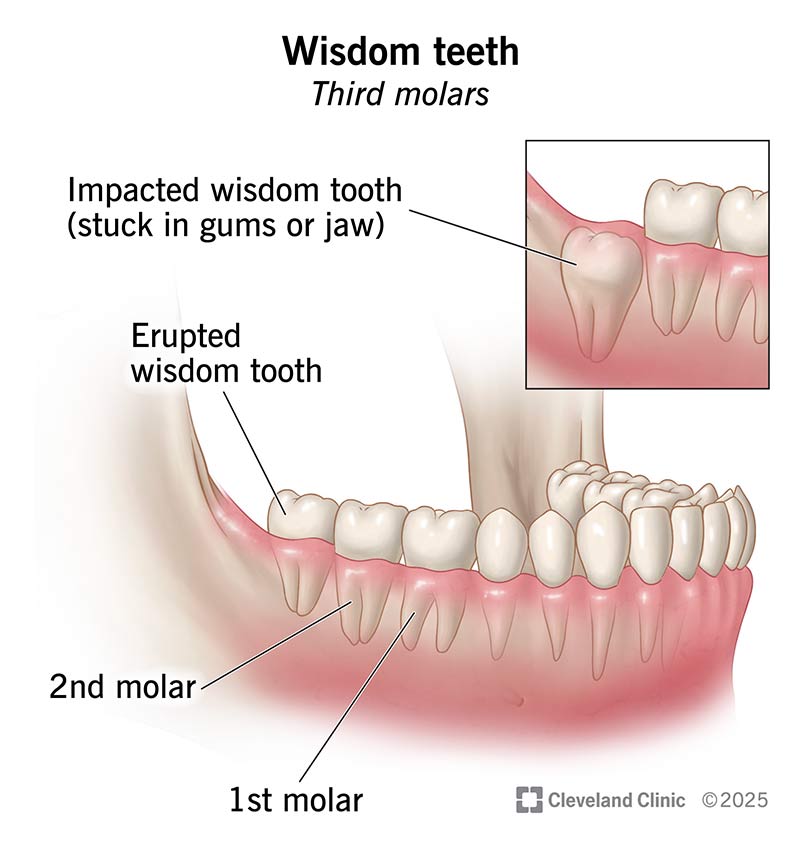Your wisdom teeth are your last set of adult teeth to grow in. They usually erupt between the ages of 17 and 25, but not everyone has them. You might need to have your wisdom teeth removed if they cause pain, infection or other oral health issues.
Advertisement
Cleveland Clinic is a non-profit academic medical center. Advertising on our site helps support our mission. We do not endorse non-Cleveland Clinic products or services. Policy

Wisdom teeth are your last set of adult teeth to erupt (grow in). Another name for wisdom teeth is “third molars.” They’re in the very back of your mouth.
Advertisement
Cleveland Clinic is a non-profit academic medical center. Advertising on our site helps support our mission. We do not endorse non-Cleveland Clinic products or services. Policy
They’re called wisdom teeth because they come in much later than your other permanent teeth. They usually erupt between the ages of 17 and 25. Most of us don’t consider ourselves old or wise in our late teens and early twenties. But like the saying goes: “With old(er) age comes wisdom.”
Sometimes, wisdom teeth grow in properly and never cause any trouble. But often, wisdom teeth get stuck in your gums or jawbone and don’t grow in (impacted wisdom teeth). When this happens, you can develop an infection, cavities, gum disease and other oral health issues. That’s why many healthcare providers recommend removing them.
If wisdom teeth erupt into their proper positions, they can provide support in the back of your mouth and preserve bone in your jaw. But in general, you don’t really need your wisdom teeth. In fact, most healthcare providers consider them vestigial. This means they served a purpose at one point, but don’t anymore.
Our ancestors’ primitive diet consisted of a lot of raw plants, hard nuts and tough meats. Wisdom teeth helped grind these foods for proper digestion.
Today, modern food preparation and eating utensils have eliminated the need for wisdom teeth. As we got used to these dietary shifts, our bodies went through some small, evolutionary changes. For example, our jaws became smaller. This is why many people don’t have enough room in their mouths for their wisdom teeth to grow in.
Advertisement
Wisdom teeth erupt in the back of your mouth, just behind your second molars. People who have all four wisdom teeth have one in each quadrant — upper left, lower left, upper right and lower right.
We have four wisdom teeth, but not all of them erupt. In about 8 out of 10 people, at least one tooth doesn’t come in. But whether zero wisdom teeth erupt or all four do, it’s all a variation of normal.
They look like any other molar. Most have two to three roots, but some can have four.
The shape of the roots can vary from person to person. Often, the roots fuse together, giving the appearance of one big, cone-shaped root. Other times, the roots can curl or splay out in different directions.
If your wisdom teeth erupt properly, you likely won’t experience any issues. But if they don’t erupt correctly or they’re impacted, they can cause issues like:
Wisdom teeth that come in partially or out of alignment can cause symptoms like:
You don’t need to have your wisdom teeth removed unless they cause issues. But if they are, a dentist or oral and maxillofacial surgeon can remove them at their office under local anesthesia or while you’re under sedation. You can have them removed under general anesthesia in a hospital when necessary.
People of any age can have their wisdom teeth removed. But to prevent future oral health complications, many people choose to remove their wisdom teeth in their late teens or early 20s. Once you remove a wisdom tooth, it doesn’t grow back.
Unlike other teeth, wisdom teeth don’t provide a lot of biting or chewing power. So, there’s no need to replace them once a provider removes them.
If you still have your wisdom teeth, your dentist will check them during routine exams to make sure they’re healthy. In addition to seeing your dentist regularly, you should practice good oral hygiene. This includes flossing daily and brushing two to three times a day.
It can be difficult to reach the back surfaces of your wisdom teeth. Take your time and make sure you’re cleaning all the hard-to-reach areas.
Wisdom teeth are vestigial (unnecessary) features of our bodies. Removing them has become a rite of passage for many teens and young adults around the globe. But if your wisdom teeth erupt in alignment with your other teeth and don’t cause any issues, you may not need to do anything. To learn more about your wisdom teeth — and whether you should remove them — talk to your healthcare provider.
Advertisement
Get the care you need today! At Cleveland Clinic, we offer specialty care that’s focused on you.

Last reviewed on 06/23/2025.
Learn more about the Health Library and our editorial process.